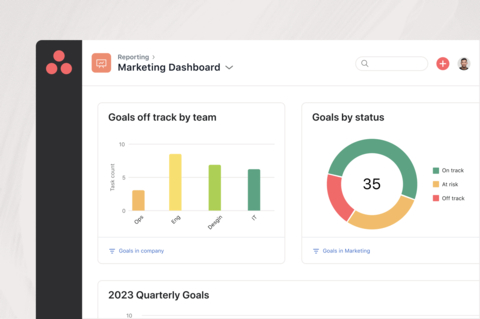Asana Launches Enterprise-Grade Goals to Help Executives Maximize Resources, Drive Revenue
Asana, Inc. (NYSE: ASAN) announced new product features aimed at enhancing organizational visibility and efficiency. The updates include Enterprise-Grade Goals for better goal tracking and resource allocation, alongside integrations with third-party tools like Salesforce to reduce cross-functional redundancies. Asana also introduced advanced security features to protect sensitive data and comply with industry standards. With these updates, the company aims to help enterprises navigate changing market conditions and improve operational efficiency.
- Introduction of Enterprise-Grade Goals enhances visibility into organizational progress.
- Integrations with tools like Salesforce reduce work redundancies and improve resource management.
- Advanced security features help organizations comply with regulations and protect sensitive data.
- None.
Insights
Analyzing...
Real-time visibility into progress across an organization and automatic updates through Salesforce inform prioritization and planning

With Enterprise-Grade Goals, enterprises have access to advanced reporting and dashboards for goals, built on the proprietary Asana Work Graph®. (Graphic: Business Wire)
Changing market conditions and unpredictable supply chain issues are forcing organizations to adapt fast – just
“Enterprise organizations face enormous uncertainty as they steer volatile market conditions. We’re hearing from our customers that they need better ways to align teams as priorities shift in order to accelerate growth,” said
Rapidly align with Enterprise-Grade Goals
Distributed team structures are prevalent within many enterprises today, making it critical for executives to have easier visibility into progress against strategic initiatives as well as accountability for business outcomes. Now, enterprises have access to advanced reporting and dashboards for goals, built on the proprietary Asana Work Graph®. These updates give executives a bird’s eye view into the status of their organization’s goals, which projects and portfolios are driving goal progress, impact on business outcomes, and roadblocks. By connecting goals in Asana with mission-critical tools like Salesforce and underlying work, ongoing goal progress is automatically updated. Goal status can easily be communicated across teams and entire organizations through reports and dashboards to make sure everyone is moving in the same direction. Goal snapshots surface key goal information at a glance for leaders.
In addition to powerful reporting, Asana is also helping teams leverage more data to aid planning. With new native time tracking features, leaders can better manage timelines by estimating how long projects and tasks will take, informing resource allocation and team workloads. This information enables leaders to easily pivot around new priorities in order to accomplish key company goals.
Increase cross-functional efficiencies by connecting tech stacks to Asana
The majority of work is done across multiple departments, yet disconnected tools make collaboration challenging and waste resources. With new ways to bring data from dozens of external tools into Asana, Asana becomes a centralized work hub where cross-functional teams can better track work being done together, avoid time-consuming redundancies, minimize costs, and decrease errors.
By expanding the ability to connect tools to Asana at every stage of a workflow, cross-functional teams can streamline work and stay up to date on progress by automatically turning updates within external apps into trackable tasks in Asana. For example, teams can get immediate visibility into technical incidents through new Asana rules integrations with Twilio, notifying individuals to urgent tasks via SMS, as well as PagerDuty, automatically alerting teams by creating an incident for timely response. Other rules integrations with Gmail and more will soon help customers aggregate information across a breadth of tools to stay connected and remove bottlenecks.
Additionally, a new Asana for Workplace from Meta integration allows teams to turn Workplace conversations into actionable tasks, manage team projects, and coordinate work without switching tools.
“The future of work is now cross-functional. There is a significant need to orchestrate collaboration across the enterprise, align around organizational goals, facilitate effective collaboration, and share project information quickly and easily,” said
Level up global security with advanced enterprise features
With enterprise tool proliferation, data security is a top concern for IT leaders. Asana’s new security features give organizations the tools to audit what information is entered into Asana, flag vulnerabilities, and maintain compliance within highly-regulated industries.
“The majority of data breaches are caused inadvertently by insiders accidentally sharing sensitive information, with a recent report2 finding that
A new data loss prevention (DLP) integration with industry leader Nightfall will soon enable teams to scan for sensitive data within Asana, such as social security or credit card numbers. A new eDiscovery integration with legal tech innovator Hanzo will soon allow organizations to easily create defensible records from Asana projects, tasks, and messages to investigate and respond to urgent incidents and litigation inquiries. Additional mobile app admin controls ensure data security and enable biometric authentication.
In order to help enterprises secure customer data and meet compliance standards, Asana is also launching additional global data centers (located in
About Asana
Asana helps organizations orchestrate their work, from small projects to strategic initiatives. Headquartered in
________________________________
1 McKinsey, The New Digital Edge: Rethinking Strategy for the Post Pandemic Era
2 Verizon Data Breach Investigations Report 2022
View source version on businesswire.com: https://www.businesswire.com/news/home/20221012005368/en/
press@asana.com
Source:







